Once patients have been registered with the follow-up centre the hCG level will be checked every 2 weeks to see if the level is falling or not. At the Charing Cross centre the measurements are initially performed on both blood and urine tests. A kit is sent to the patient that allows the samples to be posted back to us. The kit contains full details of when the blood and urine tests should be taken and how the sample(s) should be handled prior to posting.
The results are available 1-2 days after the sample is received. At Charing Cross the pattern of results for each molar pregnancy patient is reviewed and patients can telephone for their results.
The graphs above in Figures 5a and 5b show two examples of the blood hCG levels in women after a molar pregnancy. In the first graph the levels fall quite quickly reaching normal after 4 weeks, whilst in the second the levels fall more slowly taking 4 months to reach normal. Generally the length of time taken to get back to normal is less than 8 weeks; however some patients have an elevated but falling hCG level for more than 6 months and do not require any additional treatment.
In patients where the blood hCG level falls to normal the tests change to being only urine tests. The duration of monitoring varies depending on the type of molar pregnancy and when the hCG levels reach normal.
For complete hydatidiform mole patients, if the hCG level falls to normal within 56 days (8 weeks) of the evacuation then the monitoring continues for a total of 6 months from the day of the evacuation. In those patients where the hCG level takes more than 56 days to fall to normal the monitoring continues for 6 months from the date of the first normal blood sample.
For partial hydatidiform mole patients, following confirmation on the diagnosis at Charing Cross, follow up begins with serum and urine every two weeks until hCG levels are normal. This is followed by one confirmatory normal urine sample after 4 weeks.
In both situations it is advised that a further pregnancy is deferred until the end of the follow-up period, as a new pregnancy may mask the evidence of the relapse of the illness that can happen in a very small number of women.

